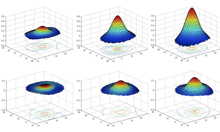Thermally induced distortion is a primary limiting factor on average power scaling in laser systems, as even passive components suffer from laser induced heating at sufficiently high average powers. The laser induced thermal distribution will be a convolution of the laser beam distribution, the substrate absorption at the laser wavelength, and the thermal conductivity of the substrate. Thus, particularly for lasers with Gaussian-like beam profiles, a ?thermal lens? will form in which the focal length is proportionate the amount of laser heating.
One pervasive issue, associated with our research and development of thulium fiber lasers, is the significant optical absorption of OH in the 2 um wavelength regime. Relative to high power ytterbium fiber lasers at 1 um, this means more absorption due to OH contamination is the fiber itself, beam delivery optics such as lens and mirrors, and even water vapor in the air. While the thermal lensing does not cause beam distortion within the fiber, due to the dominance of the waveguide, it is significant for beam delivery optics.
To characterize the significance of such effects in a variety of materials subject to high power 2 um light, we have constructed the Thermal Lens Characterization Facility. It utilizes a homemade Tm:fiber laser oscillator, producing up to 60 W average power with M2 < 1.2, with a 4 mm collimated beam diameter on the sample. The thermally induced wavefront distortion of an off-axis probe beam is measured using an Imagine Optic HASO 3 FIRST Shack-Hartmann wavefront sensor. Our measurements demonstrate >1? wavefront distortion in BK7 for an irradiance of ~1.5 kW/cm2, and ~4X larger wavefront distortion in BK7 than fused silica due to larger optical absorption and larger thermal expansion coefficient.

